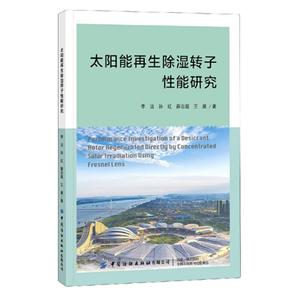扫一扫
关注中图网
官方微博
本类五星书更多>
-
>
湖南省志(1978-2002)?铁路志
-
>
公路车宝典(ZINN的公路车维修与保养秘籍)
-
>
晶体管电路设计(下)
-
>
基于个性化设计策略的智能交通系统关键技术
-
>
德国克虏伯与晚清火:贸易与仿制模式下的技术转移
-
>
花样百出:贵州少数民族图案填色
-
>
识木:全球220种木材图鉴
太阳能再生除湿转子性能研究 版权信息
- ISBN:9787518071463
- 条形码:9787518071463 ; 978-7-5180-7146-3
- 装帧:一般胶版纸
- 册数:暂无
- 重量:暂无
- 所属分类:>
太阳能再生除湿转子性能研究 内容简介
太阳能除湿空调系统的耗电量比传统制冷系统大大减少,系统可由低品位能源,太阳能作为驱动力,减少了化石能源的消耗。同时系统以空气和水分为工质,对环境无害,干燥剂还可以有效吸附空气中的污染物质,提高了室内空气品质。本书中采用菲涅尔透镜聚焦太阳能直接辐射法再生除湿转轮。对除湿转轮内部进行传热传质分析,寻找降低再生能量损失提高系统除湿率的有效途径。通过宏观、介观和微观角度介绍了太阳能除湿转轮蜂窝通道内能量分布规律、多场耦合特性、基材水分传递规律和直接光致脱附水分子的动力特性等。本书针对太阳能除湿转轮再生过程中的能量损失、深入探索转轮吸附/脱附机理进行了详细介绍,为构建高性能太阳能除湿空调系统奠定理论和技术基础。
太阳能再生除湿转子性能研究 目录
Chapter 1 Introduction
1.1 Introduction
1.1.1 Background
1.1.2 Overview of desiccant cooling system
1.1.3 Advantages of desiccant cooling system
1.2 Solid desiccant cooling research
1.2.1 Basic structure and principle
1.2.2 Historical development and progress of solid desiccant cooling system
1.2.3 Energy source for desiccant rotor regeneration
1.3 Analysis methods for desiccant dehumidification
l.3 .l Theoretical studies
1.3.2 Experimental studies
References
Chapter 2 Measurements of energy distribution within narrow channels
2.1 Energy distribution measurement of laser irradiation
2.1.1 Concept of measurement
2.1.2 Data reduction
2.1.3 Materials
2.1.4 Apparatus
2.1.5 Conditions
2.1.6 Results and discussion
2.2 Energy distribution measurement of solar irradiation
2.2.1 Concept of measurement
2.2.2 Data reduction
2.2.3 Materials
2.2.4 Apparatus
2.2.5 Conditions
2.2.6 Results and discussion
2.3 Comparison between laser and solar irradiations
2.4 Conclusions
References
Chapter 3 Predictions for energy distribution
3.1 Concept of prediction models
3.1.1 Prediction model regarding the energy absorption efficiency
3.1.2 Prediction model of view factor
3.1.3 Prediction model of Beer' s law
3.2 Parameters for silica gel sample and accuracy evaluation
3.2.1 "RE2010" model
3.2.2 View factor model
3.2.3 Beer' s law model
3.3 Comparison of models
3.4 Conclusions
References
Chapter 4 Experiment for measuring water vapour adsorption/desorption rate in desiccant rotor
4, 1 Measurement system
4.1.1 Apparatus
4.1.2 Material
4.1.3 Conditions and data evaluation method
4.2 Measurements results and discussion
4.2.1 Temperature and humidity measurements
4.2.2 Influence of inlet air temperature, humidity and humidity ratio on the dehumidifying rate
4.2.3 Influence of air flow velocity
4.3 Conclusions
References
Chapter 5 Simulation of dehumidifying process of desiccant rotor
5.1 Mathematical analysis
5.1.1 Physical model
5.1.2 Governing equations
5.1.3 Calculation condition
5.1.4 Performance indices
5.2 Results and discussion
5.2.1 Comparison between experiment and simulation
5.2.2 Distributions of temperature, humidity, moisture removal and dehumidifying (adsorption) rate within desiccant rotor
5.2.3 Influence of amount of input solar energy and rotor thickness on total adsorption rate
5.2.4 Comparison between direct and indirect heating types
5.2.5 Influence of heat transfer coefficient between bed and air
5.2.6 Influence of air flow velocity ( contacting time)
5.3 Conclusions
References
展开全部
书友推荐
- >
山海经
山海经
¥19.7¥68.0 - >
巴金-再思录
巴金-再思录
¥14.7¥46.0 - >
中国人在乌苏里边疆区:历史与人类学概述
中国人在乌苏里边疆区:历史与人类学概述
¥34.1¥48.0 - >
我与地坛
我与地坛
¥16.5¥28.0 - >
名家带你读鲁迅:朝花夕拾
名家带你读鲁迅:朝花夕拾
¥10.5¥21.0 - >
罗庸西南联大授课录
罗庸西南联大授课录
¥13.8¥32.0 - >
朝闻道
朝闻道
¥8.8¥23.8 - >
龙榆生:词曲概论/大家小书
龙榆生:词曲概论/大家小书
¥13.0¥24.0
本类畅销
-
黑科技驱动世界的100项技术
¥21.9¥69.8 -
黑科技:驱动世界的100项技术(八品)
¥21.9¥69.8 -
指火控弹道与射击诸元理论
¥38.7¥49 -
智能照明工程手册
¥29.9¥49.8 -
光电直读光谱分析技术与应用
¥38.7¥49 -
服务型制造
¥76.3¥109





















